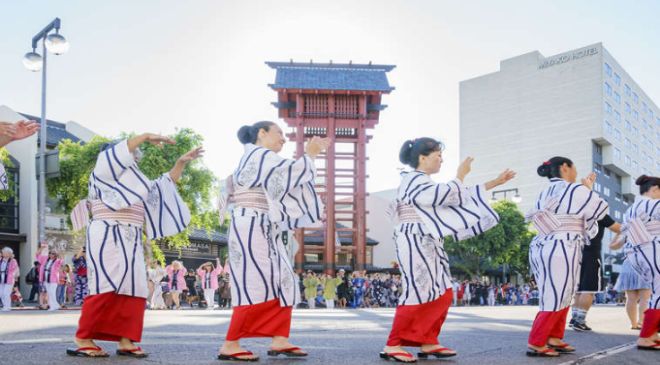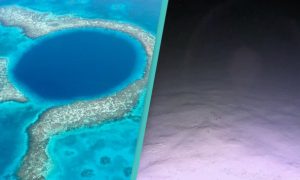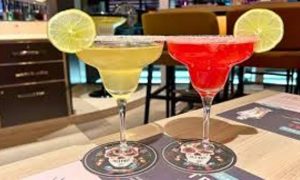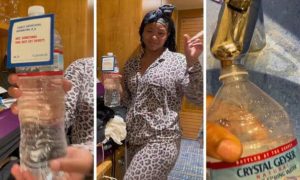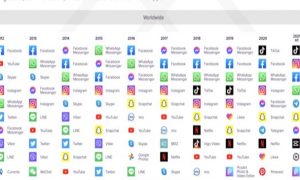Photo by Kit Leong/ShutterstockTime your Little Tokyo visit to coincide with Nisei Week in August, an annual celebration of Japanese culture.Little Bangladesh, Thai Town, Little Armenia, Koreatown, Little Ethiopia, Tehrangeles, Historic Filipinotown—if there’s a culture you want to explore, chances are Los Angeles has a neighborhood for that. One of the city’s most robust ethnic enclaves is Little Tokyo, a district on the northern outskirts of downtown L.A. that dates to the turn of the 20th century. In 1885, Charles Hama, a former seaman from Japan, opened the now-closed Kame Restaurant on East First Street (the first known Japanese-owned business in L.A.). By the early 1900s, the issei (Japanese immigrant) population boomed from just 3,000 residents to 10,000 people, leading to an explosion of Japanese-owned shops and restaurants—several of which are still open today. And so Little Tokyo was born.
One of only three official Japantowns in the United States (the other two are also in California, in San Francisco and San Jose), the area’s five-ish blocks are crammed with a sizeable Japanese American population who operate and frequent the district’s old-school sushi joints, streetwear vendors, Instagrammable soft-serve spots, manga hotspots, and more. Consider this to be your indispensable guide to one of L.A.’s most bustling, delicious, and explorable nabes.

Photo by Zak Kelley, courtesy of the Museum of Contemporary ArtInstallation view of “The Foundation of the Museum: MOCA’s Collection,” on view through January 27, 2020, at the Geffen Contemporary at MOCA.
What to Do in Little Tokyo
The Japanese American Cultural & Community Center
The Japanese American Cultural & Community Center is the largest Asian American cultural center in the United States and the heart of the Japanese American community in Los Angeles. Additionally, JACCC offers visitors a peaceful respite from the hubbub of the city with its James Irvine Japanese Garden, also known as Garden of the Clear Stream (apropos, considering a stream cuts through the lush green space). Cedar bridges serve as a dreamy stopping point to admire the flowers and foliage. Once you’ve soaked up some nature, catch a performance from Asian American musicians or maybe Kabuki performers at JACCC’s Aratani Theatre, or improve your culinary skills with a Japanese cooking class or seminar through JACCC’s Toshizo Watanabe Culinary Cultural Center.
Japanese American National Museum
Brush up on your Asian American history at the Japanese American National Museum, the largest museum in the United States dedicated to the Japanese American experience. There’s a permanent collection of over 60,000 artifacts and the exhibitions are impressively disparate: Shows examine everything from the cultural legacy of Hello Kitty to WWII-era Japanese internment camps.
Geffen Contemporary at MOCA
Nearby, you’ll find the Geffen Contemporary at MOCA, an outpost of downtown L.A.’s Museum of Contemporary Art—it holds a vast collection of over 7,000 pieces of artwork. The building that the Geffen Contemporary currently resides in was once a police car warehouse and is dedicated to showcasing the most cutting-edge fads in modern art. Some current exhibits include Untitled (Questions) by Barbara Kruger—a striking 30 by 191 feet red, white, and blue mural that poses questions like “Who is beyond the law?”—Our House: Selections from MOCA’s Collection, which features pieces from the 1950s to the present day, and Jennifer Packer: Every Shut Eye Ain’t Sleep, an exhibit completely dedicated to the works of the New York City-based artist.
Higashi Honganji Buddhist Temple
The Higashi Honganji Buddhist Temple is a part of the Shinshu Otani-ha sect of Buddhism, one of the oldest and most popular denominations in Japan. Established in 1904 and moved two times before being settled in its present day location in 1976, Higashi Honganji was L.A.’s very first Japanese Buddhist temple. Constructed in a traditional Japanese architectural-style, the temple features 30,000 imported roof tiles, a breathtaking statue of Buddha and matching altar display, as well as a gorgeous garden that’s maintained by temple members. Sadly, the temple has been temporarily closed to visitors because of COVID since last March and was recently vandalized in February 2021.
Max Karaoke Studio
After an afternoon of museums and temples, you may be in the mood for something a little less serious. Consider renting a room with a couple of friends at Max Karaoke Studio, and belt out the classics till you’re hoarse. Max Karaoke is not exactly a high-end karaoke spot, but it is indisputably a Little Tokyo mainstay. Formerly BYOB, the studio now offers a $6 per person happy hour and thoroughly cleans the rooms in between parties.
Nisei Week
You might want to book a trip to Little Tokyo around one of the many festivals held there each year. Nisei Week takes place every August and celebrates Japanese culture with a DekoCar show (a parade featuring cars covered in custom anime, manga, or video game graphics), public street dancing, and the World Gyoza Eating Championship (where competitive eaters consume as many gyoza, or Japanese pot stickers, as they can in 10 minutes). Of course, there are also other festivals that also take place in Little Tokyo throughout the year including the Los Angeles International Tea Festival, which usually takes place some time in August, and the L.A. Art Book Fair (one-stop-shop for artbook–centric reads from artists, antiquarian booksellers, small presses, and institutions), which is held in April.

Photograph by Shutterstock/Kay EckerBe sure to come on an empty stomach when visiting Little Tokyo.
Where to Eat and Drink in Little Tokyo
Demitasse
You’re going to need some fuel for this sojourn, so consider grabbing a Kyoto-style (aka slow-drip) iced coffee from Demitasse. If coffee isn’t your thing, try the hot chocolate, which comes with an enormous brûléed marshmallow. You could take it to go, but we suggest you stay and sip awhile on the outdoor patio shaded by an awning of suspended umbrellas.
Daikokuya
Some may consider this restaurant to be a tourist trap, but this famous ramen shop is busy for a reason. Though there are now four Daikokuya locations across Los Angeles, the one in Little Tokyo is the original restaurant and visiting it is considered to be something of a necessary pilgrimage by fanatic noodle heads. Their ramen features a milky tonkotsu broth seasoned with their secret blend of soy sauce, which is accompanied by firm egg noodles, tender kurobuta pork, ajitama (a marinated, soft-boiled egg), bamboo shoots, sesame seeds, and green onions. Waits at Daikokuya can sometimes top an hour (especially on the weekends), so consider checking out Shin-Sen-Gumi Hakata Ramen, which also serves up toothsome tonkotsu broth.
Marugame Monzo
If you’re in the mood for noodles but ramen seems too heavy, consider checking out Marugame Monzo. This restaurant offers sanuki-style udon which is characterized by its square-shaped noodle and irresistible chew—in fact, sanuki-style noodles are some of the most popular in all of Japan. Whereas ramen features thin noodles served in a hearty bone broth, udon offers chunky wheat noodles served in a clear, dashi-based broth. Some spots around Little Tokyo can feel a bit old school, but Marugame Monzo’s atmosphere is decidedly contemporary and the restaurant even offers tempting fusion dishes like Miso Carbonara Udon and Seafood Tomato Cream Udon.
Hama Sushi
This no-frills restaurant takes its sushi very seriously. A sign next to the door reads “Only sushi and sashimi. No tempura. No teriyaki. No noodles. No rice alone.”—and they mean it. With just 19 tables and a no-reservation policy, visitors should plan on having to wait awhile to eat here. However, Hama Sushi has a reputation for being one of the best sushi restaurants in the area. Since there is such a small seating area, waitstaff are very attentive and dishes are often ready to eat minutes after ordering. Expect thick cuts of very fresh fish and warm, fragrant rice.
Fugetsu-Do
Fugetsu-Do is a true Little Tokyo O.G. Founded in 1903, this cute shop serves up gorgeous, hand-crafted mochi confections. The business is family-owned and is currently operated by the clan’s third generation of mochi artisans. Fugetsu-Do offers a wide range of mochi varying from gem-like, modern creations featuring strawberry and peach flavorings to more traditional selections that are filled with red and white sweet beans. Just be sure to go early on the weekends—due to COVID, only a few people are allowed inside at a time and there’s often a line running out the door.
Suehiro Cafe
When it comes to Japanese comfort food, it’s hard to beat Suehiro Cafe. Started by two sisters more than 49 years ago, Suehiro Cafe offers a large menu that features plenty of Japanese favorites including things like agedashi tofu, tender tonkatsu, and chazuke. Suehiro Cafe is not the place to go to experience glitzy, upscale Japanese dining, but a place to enjoy authentic Japanese food in a relaxed and homey atmosphere.

Photo by Unsplash/Ken HiltonIn 1941, Little Tokyo residents were forced to abandon their homes and the neighborhood virtually shut down.
Where to Shop in Little Tokyo
Poketo
Poketo is a bright, airy shop specializing in accessories and home goods. Their collection will speak to anyone with a modern aesthetic: quirky bike helmets by Thousand; vintage typewriter-style keyboards for your desktop; chocolates from local confectionary Compartés (try the Churros and Horchata bar); out-there scents from Na Nin (in case you’ve ever wanted to smell like “Cannabis/Opium Den.” Poketo was founded in 2003 by husband-and-wife duo Ted Vadakan and Angie Myung who strive to help visitors infuse a healthy dose of art and design into their customers’ everyday lives. The shop also often puts on art exhibitions highlighting local artists, workshops, and other types of fun events.
Kinokuniya
“Kinokuniya” means “Bookstore of Kii Province” in Japanese and is the largest bookstore chain in Japan. However, the company is not satisfied with just being the top dog in their home country—it’s intent on establishing a global presence in the retail book world. Because of that lofty goal, Kinokuniya offers books and magazines in both Japanese and English in U.S. stores. Kinokuniya is a bookworm’s dream with art tomes, manga, niche magazines, and all sorts of other genres, not to mention an extremely satisfying array of pens, journals, and art supplies up for sale.
Entertainment Hobby Shop Jungle
Have an arguably unhealthy obsession with an anime character or collect Funko Pops? Definitely check out this J-town staple. Located in the Little Tokyo Mall beneath a parking garage, Entertainment Hobby Shop Jungle (also known as Anime Jungle) was originally founded in Osaka, Japan in 1995 and specializes in selling anime figurines, mangas, and collectibles, as well as independent films made by Japanese directors.
Japangeles
L.A.-born designer Roy Kuroyanagi’s Japangeles is a beacon of minimalist streetwear and an homage to his roots (his grandparents were residents of Little Tokyo). Swing by to stock up on T-shirts, sweatshirts, and snapback hats that put a Southland twist on Japanese iconography (one tee features a lucky maneki-neko, one of those waving cats, with shades on).
Make Asobi
If you’re looking to buy some things to pamper yourself with, mosey on over to Make Asobi and upgrade your beauty routine with myriad Japanese sheet masks, makeup, and hair products. In addition to tried-and-true drugstore brands like Hada Lobo and Shiseido, Make Asobi also keeps high-end products in stock like Shu Umera.
Where to Stay in Little Tokyo
Miyako Hotel
Situated just a few blocks from Union Station in the heart of Little Tokyo near all of the neighborhood’s best places to eat and drink, this hotel’s location is hard to beat. The Miyako Hotel is actually part of the Miyako Hotels and Resorts chain, which is headquartered in Osaka, Japan. Their Little Tokyo outfit primarily caters to Japanese tourists on vacation in Los Angeles and offers amenities that might appeal to such a clientele like high-tech bidets, ultra-clean rooms, a Japanese-style spa, and an in-house sushi restaurant. As an added bonus, if you’d like to venture beyond the streets of Little Tokyo, the hotel is just one mile from the Walt Disney Concert Hall and two miles away from the Staples Center.
DoubleTree
This DoubleTree is conveniently located in between Little Tokyo and L.A.’s Art District. With 434 rooms, it’s a reliable place to find a place to sleep in a pinch. But perhaps the biggest highlight of the hotel is its unique rooftop garden which is actually a recreation of an ancient Tokyo garden built for 16th century samurai lord Katō Kiyomasa and features a waterfall, a wooden bridge, and a pond. The garden is a popular outdoor event space that can hold up to 300 people, but it’s also just a nice place to stroll through in the mornings after breakfast.
Getting to Little Tokyo
If you’ve spent even a femtosecond in L.A., you know that driving and parking in the city can be soul crushing. But abandoning your ride is easy in Little Tokyo. The best place to park in the neighborhood is arguably the Judge John Aiso parking lot which offers a $3.00 flat rate parking fee after 5:00 pm. You could also roll up to Weller Court and use the plaza’s underground garage, where parking all day will only set you back $10. (Head’s up: It’s cash only.) If you’re going car-less, you can catch the Metro Gold Line to the Little Tokyo/Arts District station—yes, there’s a train in L.A.—or hitch a ride via Uber or Lyft.

